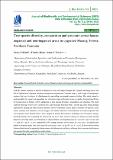Tree species diversity, composition and structure across human impacted and non-impacted areas in upgraded Marang’ Forest, Northern Tanzania

View/
Date
2021-11-26Author
Nchimbi, Grace
Moyo, Francis
Treydte, Anna
Metadata
Show full item recordAbstract
Globally, forests’ capacity to provide ecological services and support human life is rapidly declining due to the lack of deployment of proper resource management approaches. Countries adopt a wide range of management regimes that vary in degree of effectiveness in controlling unstainable human activities. This study aimed at understanding the impacts of upgrading the protection status of forested areas to a higher International Union for Conservation of Nature (IUCN) categories on tree species diversity, composition, and structure. The study explored Marang’ Forest (MF), annexed into Lake Manyara National Park a decade ago after being strongly impacted by mining and other human activities. It uses concentric circular plots to identify tree species, count stems, measure tree diameter at breast height, and assess indicators of disturbances in human-impacted and non-impacted areas. Results show a lower degree of human disturbances, including wood extraction, mining, livestock grazing, and trespassing has deterred in the forest. Tree species richness was about one third, and the Shannon’s diversity index was 17% higher, in impacted than non-impacted areas (t = 5.03, df = 34, P <0.001 and t = 4.98, df = 34, P < 0.001, respectively). The average number of tree stems ha-1 was 640 ± 26 significantly higher in impacted areas than non-impacted areas (524 ± 22; t = 3.46, df = 34, P = 0.01). It shows that lowering human disturbances by upgrading forests reserve to higher protected status enhance forest recovery and improve tree species diversity, composition, and structure.
